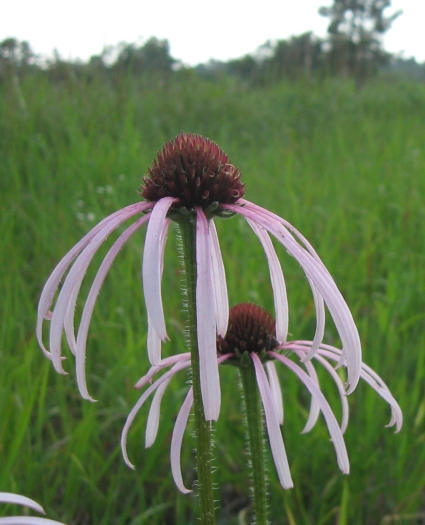Wavyleaf Purple Coneflower
(Echinacea simulata)
Wavyleaf Purple Coneflower (Echinacea simulata)
/
/

Mason Brock (Masebrock)
Public domain
Image By:
Mason Brock (Masebrock)
Recorded By:
Copyright:
Public domain
Copyright Notice:
Photo by: Mason Brock (Masebrock) | License Type: Public domain | License URL: https://creativecommons.org/public-domain/ | Uploader: Rrburke | Publisher: Wikimedia Commons | Title: Echinacea_simulata.jpg | Notes: User created page with UploadWizard |





























Estimated Native Range
Summary
Echinacea simulata, commonly known as Wavyleaf Purple Coneflower, is a deciduous perennial herb native to open woodlands, prairies, and savannas of the Southeastern and Central USA. It typically grows from 50 to 100 cm (20-40 inches) tall and arises from a branched fusiform taproot. The plant features narrow, lance-shaped leaves with wavy margins and bears showy daisy-like flowers with pink to purple rays and a central cone that is usually orange or brown. Flowering occurs in the summer, and the flowers are highly attractive to pollinators such as bees and butterflies.
Wavyleaf Purple Coneflower is valued for its striking flowers and its ability to attract wildlife, making it a popular choice for native plant gardens, pollinator gardens, and naturalized areas. It is also used in traditional medicine. This species is relatively easy to maintain, tolerating drought once established. It prefers full sun to part shade and thrives in well-drained soils. While generally disease-resistant, it can occasionally suffer from aster yellows or powdery mildew.CC BY-SA 4.0
Wavyleaf Purple Coneflower is valued for its striking flowers and its ability to attract wildlife, making it a popular choice for native plant gardens, pollinator gardens, and naturalized areas. It is also used in traditional medicine. This species is relatively easy to maintain, tolerating drought once established. It prefers full sun to part shade and thrives in well-drained soils. While generally disease-resistant, it can occasionally suffer from aster yellows or powdery mildew.CC BY-SA 4.0
Plant Description
- Plant Type: Herb
- Height: 2-3 feet
- Width: 1-2 feet
- Growth Rate: Moderate
- Flower Color: Brown, Pink
- Flowering Season: Summer
- Leaf Retention: Deciduous
Growth Requirements
- Sun: Full Sun, Part Shade
- Water: Medium
- Drainage: Medium, Fast
Common Uses
Bee Garden, Bird Garden, Butterfly Garden, Deer Resistant, Drought Tolerant, Fragrant, Hummingbird Garden, Low Maintenance, Rabbit Resistant, Showy Flowers, Street Planting
Natural Habitat
Native to open woodlands, prairies, and savannas
Other Names
Common Names: Pale Purple Coneflower
Scientific Names: , Echinacea simulata, Echinacea pallida var. simulata,
GBIF Accepted Name: Echinacea simulata Mc Gregor